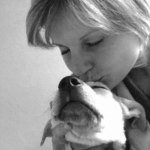It takes two to three weeks for the body to adapt to a temperature change of more that 10 degrees F. As the temperature begins to drop your dog will have to adapt to these changes. Some of these changes will affect dogs in different ways and will depend on the breed, coat length, age, and overall health of your dog. If a dog is thin or underweight they won’t have much protective fat for insulation. Older dogs in general also are less able to thermoregulate at temperature extremes. Wind and wet conditions will magnify the effects of low temperatures.
o Cold can increase stiffness:
Some researches think that in cooler, damper weather there is a drop in barometric pressure, this is the force exerted by the weight of the atmosphere. This drop can affect the joints by allowing the tissues in the joints to swell, which then puts pressure on the nerves. Minor variations in barometric pressure should not cause pain in the joints but some discomfort might be felt. Other proposed causes of joint pain and stiffness when it is colder is that the changes in the body that are associated with cooler weather can amplify pain signals from the joints. The weather outside, shorter days and colder temperatures may decrease the exercise our pets get in the winter which results in inactivity which can make arthritis pain worse. Whatever the reason behind why joints may be more painful when the temperature drops, it is important to get moving, even a little each day and watch for signs of pain or lameness and have your pet seen by a veterinarian if you notice anything concerning.
o Increase chance of slipping/falling:
During icy and snowy conditions, the incidence of slips and falls increases. Avoiding these slippery surfaces is ideal but when unavoidable there are a few things that can be done to help keep you and your dog safe. Booties can make slipping worse depending on the boot due to a lack of traction. Rubber booties are not very insulating but can provide the traction necessary for a walk on a slippery surface. Make sure to remove the bootie after the walk as keeping them on for too long is not recommended. The booties can not only help with traction but can also form a barrier between your dog’s paws and protect them from the salt, chemicals and ice that they walk through. It is recommended to clean your dog’s paws and abdomen with warm water to remove any ice or salt that they may have gotten on their paws or fur during the walk and then make sure to dry them so that they don’t get chilled.
o Dogs rely heavily on strong sense of smell to know where they are –
The snow covered ground or snow storm easy to get disorientatio so don’t let your dog off leash on ice or snow since dogs can lose their scent and easily become lost.
o Some dogs may need to eat more (takes more energy to keep warm):
Some dogs may need a slight increase in calories once the temperature drops below a certain temperature in order to maintain body heat. Dogs subjected to cold have an altered metabolism which may cause weight loss due to these changes, however this is not a reason to start feeding more since not all dogs need this bump in calories, especially if they are sedentary in the winter. If you are not sure about changing the diet talk to your veterinarian, especially if your dog is already on a weight loss plan.
o Irritation to paw pads:
Be sure to wipe off your dog’s paws immediately after getting home to prevent ingesting rock salt or other chemical de-icers while licking paws. The ice, salt and chemicals can sting, dry and crack paw pads. Be sure to check in between the toes also and remove any clumps of ice and snow gently.
Just like in the summer, never leave your dog alone in a car during cold weather. Cars hold in the cold, acting like refrigerators, and this can cause hypothermia and even death. Remember, if it feels too cold for you then it is probably too cold for your dog. Be aware of weather changes and make sure to keep your pets warm and dry in the cold weather months.




